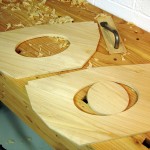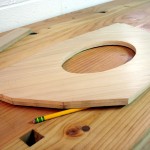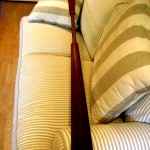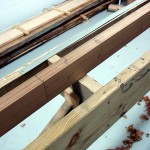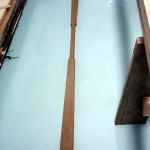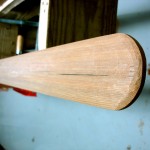The best reason for this post is to rave about how well the long workbench works.
The Fiddlehead’s bottom is made of three pieces of edge joined cedar, finished to 9/16″ thick. The center board is 11 feet long. The edge boards are each 8 feet long, and everything fits easily on the long bench.
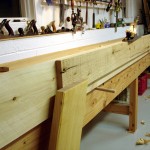 The front apron is especially helpful for jointing the edges. Each of the boards had one face surfaced as a flat reference surface. Then, they are clamped on the apron in the correct relationship and their edges jointed together. Jointing them together ensures their edge angles match. The quick set up on the apron makes it easy to release and flip the boards up onto the bench for test fitting, and then set back up for fine tuning. I found it surprisingly easy to get to a “sprung joint” that was tight on the ends and about 1/32″ open in the middle. One clamp in the center was enough to produce evenly distributed squeeze-out during glue up. About as close to perfection as one can get, and it took surprisingly little effort. Yet, I did actually use more than one clamp, just to be certain. The primary thing holding the bottom of the boat together is these edge to edge glue joints.
The front apron is especially helpful for jointing the edges. Each of the boards had one face surfaced as a flat reference surface. Then, they are clamped on the apron in the correct relationship and their edges jointed together. Jointing them together ensures their edge angles match. The quick set up on the apron makes it easy to release and flip the boards up onto the bench for test fitting, and then set back up for fine tuning. I found it surprisingly easy to get to a “sprung joint” that was tight on the ends and about 1/32″ open in the middle. One clamp in the center was enough to produce evenly distributed squeeze-out during glue up. About as close to perfection as one can get, and it took surprisingly little effort. Yet, I did actually use more than one clamp, just to be certain. The primary thing holding the bottom of the boat together is these edge to edge glue joints.
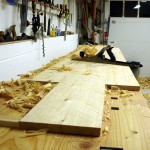 The shop temperature is near the minimum for West System epoxy, so I let it cure a full 24 hours before moving on to thickness planing. Two dogs, two holdfasts, and a couple of turns on the tail vise gets the piece set up for planing in about 10 seconds. Plane one side for a while. Flip it, and plane the other side. Rinse, lather, repeat until we get to 9/16″. The big ole heavy #7 is rank set for a moderate cut; reasonably good material removal with no tearout.
The shop temperature is near the minimum for West System epoxy, so I let it cure a full 24 hours before moving on to thickness planing. Two dogs, two holdfasts, and a couple of turns on the tail vise gets the piece set up for planing in about 10 seconds. Plane one side for a while. Flip it, and plane the other side. Rinse, lather, repeat until we get to 9/16″. The big ole heavy #7 is rank set for a moderate cut; reasonably good material removal with no tearout.
